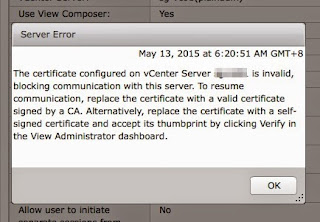VMware Tools Missing!
Recently, I was in a Facebook group, VMware vExpert and one member actually posted this.
He was running a VDI environment and notice his VMware Tools got uninstalled and was not able to install successful after several attempt. This is a VMware issue, but let's looks more into it.
With further check, the user did a update to their ESXi host, and vSphere auto update the VMware Tools to every virtual machine that got rebooted. During the installation, whether auto or manual triggered by user, it fails. With an investigation by the member, it seems his anti-virus has blocked the installation.
But wait right here, how did vSphere did auto update of VMware Tools? Isn't that trigger normally by using the vCenter Update Manager (prior to vSphere 7.0) or vCenter Lifecycle Manager (vSphere 7.0 onwards)?
A good thing the member found this article by one of our VCDX.
It seems that there is an auto update of VMware Tools to patch ESXi host if you check that on as show by vMiss.net.
From the above screenshot, you can setup auto update to match a host. It sounds great but it may not be particularly useful especially when you are running a virtual desktop infrastructure (VDI) environment.
Similarly, I have encountered a customer issue at the same time and manage to link both cases together.
Let me explain here. You do have a master image for VDI which will have most of the base software such as anti-virus agent been installed. Every desktop created from the master image, it typically starts from a reboot status, in this case, VMware Tools will be triggered to be installed. This is done often especially when policy is set to create new or refresh a desktop when a user logs off. And this also happens during a regular maintenance to refresh a desktop pool.
Now the problem comes, AV are typically setup to prevent system installation specially to prevent any intrusion action. In this case, VMware Tools is one of such installation and this got blocked. This causes unnecessary panic where user start to relate this to a vSphere or a VDI solution issue.
This does not often relate to a solution issue, but a setting been used based on a design. One would need to assess whether this makes sense for any solution and understand the caveats that comes with it. For someone who took over an environment without prior knowledge will not be aware and will waste a lot of time troubleshooting.
There is also one more caveat, when upgrading your ESXi host and working with VDI solution such as Horizon or any other solution, you need to ensure that compatibility even for the VMware Tools. The VMware Product Interoperability Matrices site will be an especially useful to bookmark. An example Horizon 7.7 with vSphere 6.7U3. In this case, we do not upgrade the VMware Tools from host upgrade and not enable Auto Update.






Comments